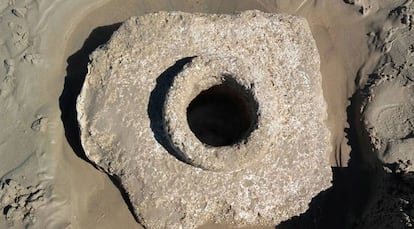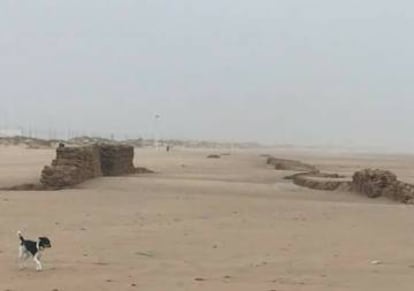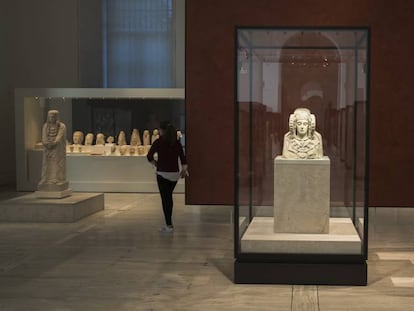Storm uncovers ancient remains of Roman aqueduct and road in Cádiz
Waterway dates to 1st century and is deemed one of the greatest feats of engineering in Roman Hispania

There is a famous song by Antonio Rodríguez Martínez, aka El Tío de la Tiza, that was sung at the Cádiz carnival of 1905 chronicling a fisherman’s discovery of 18th-century coins at La Victoria beach. In the song, locals rush in with shovels to extract the valuable coins from the sand.
Now, 114 years later, a similar scene has unfurled at Cortadura beach: when local residents walked out on the sand following the recent storm, they were amazed to find remains of a Roman aqueduct and parts of a stone road dating back to the 16th or 17th centuries.
Two of these fragments are still joined together with the original mortar, which is a rare occurrence
Moisés Camacho, heritage expert
“We were alerted to the presence of these remains, and to the fact that people were digging in the area, so we went there, warned people to stop what they were doing, and called city officials,” explains Moisés Camacho, president of the Association for the Investigation and Dissemination of Cádiz’s Heritage (Adip).
Soon after that, the municipal archeologist and a local police patrol car showed up to watch over the remains on a stretch of beach that runs parallel to the road connecting Cádiz and San Fernando.
Experts have identified remains of two walls around 80 centimeters thick and two meters high that once delimited the road, said Eugenio Belgrano, a member of Adip and president of the Association of Underground Investigators.

This road was used until 1755, when it was destroyed by a tidal wave triggered by the great earthquake in Lisbon. The tsunami swept through Cádiz and Huelva, killing 1,240 people.
Not two meters from this road, archaeologists have identified up to seven fragments of what might have been the aqueduct of Gades (the Latin name for modern-day Cádiz), a Roman construction built in the first century. “Two of these fragments are still joined together with the original mortar, which is a rare occurrence,” said Camacho.
Historians had already been aware of of the existence of both the aqueduct and the road, although no finds had emerged in recent decades.
The Roman aqueduct of Cádiz once stretched over 75 kilometers, bringing residents water from the springs of Tempul, in San José del Valle. It is considered one of the greatest feats of engineering in Roman-era Hispania. Other similar aqueduct fragments found years ago are now on display in Cádiz’s Asdrúbal square.
Scholars believe that there could also be an older Roman road right underneath its 17th-century counterpart, or else running parallel to it under the sea.
English version by Susana Urra.
Tu suscripción se está usando en otro dispositivo
¿Quieres añadir otro usuario a tu suscripción?
Si continúas leyendo en este dispositivo, no se podrá leer en el otro.
FlechaTu suscripción se está usando en otro dispositivo y solo puedes acceder a EL PAÍS desde un dispositivo a la vez.
Si quieres compartir tu cuenta, cambia tu suscripción a la modalidad Premium, así podrás añadir otro usuario. Cada uno accederá con su propia cuenta de email, lo que os permitirá personalizar vuestra experiencia en EL PAÍS.
¿Tienes una suscripción de empresa? Accede aquí para contratar más cuentas.
En el caso de no saber quién está usando tu cuenta, te recomendamos cambiar tu contraseña aquí.
Si decides continuar compartiendo tu cuenta, este mensaje se mostrará en tu dispositivo y en el de la otra persona que está usando tu cuenta de forma indefinida, afectando a tu experiencia de lectura. Puedes consultar aquí los términos y condiciones de la suscripción digital.
More information
Archived In
Últimas noticias
Welcome to the post-religion era: The idea of Christianity as the absolute truth has become obsolete
‘I thought you would like it’: The risky sexual practice popularized by TV shows and TikTok
The digitalization of tourism: ‘They promise experiences and gave us the worst possible one’
Mexican peso defies uncertainty with forecasts of a new period of stability in 2026
Most viewed
- Sinaloa Cartel war is taking its toll on Los Chapitos
- Reinhard Genzel, Nobel laureate in physics: ‘One-minute videos will never give you the truth’
- Oona Chaplin: ‘I told James Cameron that I was living in a treehouse and starting a permaculture project with a friend’
- Why the price of coffee has skyrocketed: from Brazilian plantations to specialty coffee houses
- Silver prices are going crazy: This is what’s fueling the rally











































